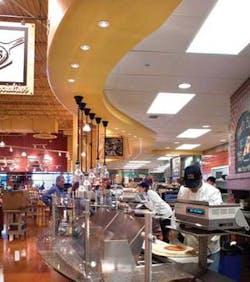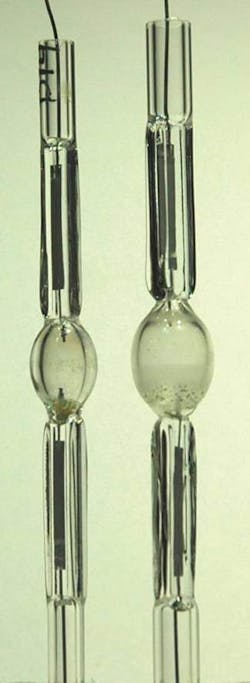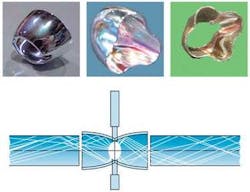FIBERS FOR ILLUMINATION: Fiber illumination technology leapfrogs efficiency barriers

The grant money has enabled its recipient, Energy Focus (formerly Fiberstars; Solon, OH) to upgrade conventional fiber-optic lighting technology (which the company still offers) from being the least efficient form of indoor lighting at 2 to 3 lumens per watt, to the most efficient at 60 l/W. And the company expects to reach 70 l/W by next year, says CEO John Davenport, a 25-year veteran of GE Lighting, who points out, humbly, that the Sun remains the most efficient source of outdoor lighting. The overall efficiency improvement was achieved through a cumulative improvement of four times in the light source, between two and three times in the coupling optics, and another two times in the optical-fiber transmission lines.
The source
The fourfold improvement in source efficiency was obtained by switching from halogen lamps, offering incandescent efficiencies under 20 l/W, to metal-halide high-intensity-discharge (HID) sources offering 90 l/W. However, custom design of the HID sources was necessary for both market and technical reasons.
The market requirement for most indoor illumination tasks is on the order of 500 to 1000 lumens. But the high luminous efficiency of metal-halide HID sources is generally obtained through the kilowatt-class lamps that provide illumination in athletic stadiums. A decade ago, attempts to apportion 100 klumen sources into 0.5 to 1 kl fiber channels proved inefficient and unwieldy, according to Roger Buelow, chief technology officer of Energy Focus. Attempts to make HID lamps at the 0.5 and 1 kl sizes needed for indoor illumination, on the other hand, ran afoul of physical limitations.
“From the science aspect, you can scale metal halides down to smaller and smaller sizes, but there are inherent losses that cause the light-generation efficiency to suffer more at smaller sizes,” Buelow says. “They include the voltage drop across the electrodes and heating up of the quartz body. These factors don’t scale down with power as much as the light output, so there is a point, a little less than 70 W, at which they take over and you begin to lose the efficiency benefits of metal-halide science and lamps.”
As it happens, Buelow, Davenport, and colleagues also found that they could distribute the light most efficiently by limiting the number of fiber-optic channels to between six and eight. So a 70 W source distributed over between six and eight fiber channels at 60 to 70 l/W seemed to offer a perfect solution, but not without further challenges.
Highly efficient distribution also required close contact between collector optics and the arc chamber in the center of the lamp to prevent trapping light within the optic. But conventional metal-halide sources are short lived in the atmosphere so they are usually hermetically sealed in glass bulbs containing a passive nitrogen atmosphere and rely upon a large reflecting dish inside the enclosure to direct light outward. To place the collection optics (about the size of a quarter) in contact with the arc chamber (about the size of a dime), however, the engineering team at Energy Focus needed to operate the arc chamber in ambient air. This required a redesign of the lamp and materials to avoid oxidation, while maintaining the same basic arc chamber structure (see Fig. 2).
The optics
The redesign, however, required rethinking the approach to collection optics. The conventional approach involves placing a point source at one focus of an elliptical reflector and collecting reflected light at the other focus. But the 70 W lamp requires a 7 mm arc tube. As noted, scaling the arc gap any smaller loses efficiency and introduces lifetime problems caused by the huge thermal gradient. Not only is there no way for a 7 mm arc-gap chamber in direct connection with collection optics to present a point source, Buelow explains, but elliptical optics also do not provide the needed collection efficiency. The elliptical reflector only grabs about 70% of the light, while 30% is lost through the minor axis.“We couldn’t afford to throw this much light away,” Buelow says. “So we went from a reflective to a collective strategy using nonimaging optics. We just grab everything coming within a 38° half angle, and if it’s not in that direction, then we nudge it in the right direction with a mirror.” The approach, essentially the same one used in photovoltaic concentrator systems, takes the broad angle of light coming from a lamp and directs it onto the target area for entering a light pipe, with efficiencies well in excess of 90%. The 38° parameter came from the need to achieve total internal reflection in a polymer optical fiber with an acrylic core refractive index of 1.5 and a fluorpolymer cladding refractive index of 1.33.
The optics, referred to as compound parabolic concentrators, are made from the same quartz material used in undersea transmission cables, enabling them to withstand the 800°C temperatures at the surface of the light source. The reflective surface is coated with 24 thin-film layers, each on the order of a wavelength of light in thickness with differing refractive indices between adjacent layers that form a dichroic (multilayered dielectric) mirror offering reflectivity percentages in the high nineties.
To accommodate the relatively long arc gap, the optics present a parabolic collection geometry that is too steep to be coated in traditional ways while maintaining homogeneous reflectivity over the entire surface. So Buelow, Davenport, and colleagues developed a low-pressure chemical-vapor-deposition method that enables cost-effective fabrication of the optics in high volumes. In addition to avoiding the heat damage that might be caused by metal mirrors, the dichroic mirrors also enable the relatively compact and lightweight illuminators to filter out unwanted IR and UV radiation, without the multiple levels of glass filters that are characteristic of conventional fiber-illumination systems (see Fig. 3).
The fiber
The third element in the efficiency-improvement equation related to piping the light to where it is needed. “A cable for a telephone call is about the same thickness as a human hair and transmits IR light,” Davenport said. “You need a million times more light to read by or shop under. So you also need a fiber-optic cable that is about a million times thicker. Something like this could be fabricated in quartz but it would not bend. So we make plastic cable that is 10 mm in diameter and that can bend. We make it continuously, here in Solon.”
The challenges involved were not insignificant, Buelow explains. The fiber needs to be stiff enough to stand on its own once installed in a building but also flexible enough to perform the intended function of routing light, which Buelow characterizes as combining the toughness of a tire with the flexibility of a wire. To fabricate the fiber economically in large quantities they co-extrude the two optical parts (core and cladding) on a take-up reel, several miles at a time.
Because material with the consistency of a tire would be too thick to extrude, they resorted to a two-step process. A relatively soft material is extruded in the first step, and then the second step imparts the stiffness necessary to withstand the rigors of building construction. All of this had to be accomplished while maintaining high levels of optical clarity.
“In bullet-proof glass, which is only an inch thick, or the plastic walls in large public aquariums, which is only about 6 in. thick, you lose a lot of light in transit and can see a color shift,” Buelow explains. “In this case, over 10 ft of optical cable, we have to maintain superclarity, both to get the light through and to maintain the brilliant clear white color quality.” The process was developed under a grant from the NIST ATP program. “We were considered very high risk then, but we got it to work,” Davenport says.
LEDs at sea
Currently, the Energy Focus fiber-optic technology is being tested by the U.S. Navy for a broad array of shipboard illumination tasks. One of those tasks-providing the relatively soft lighting needed for a sailor’s sleeping compartment-presents additional challenges. Only 100 to 200 lumens is required, less than one-half of the lowest intensities efficiently achievable with HID lamps. The answer is to use LEDs.
“LEDs are a different source from metal halide, but they are similar optically,” Buelow says. “You need an encapsulant over the LED to get the light out because you are pulling it out of a high-index material. Without the encapsulant, Fresnel reflections would cause problems, which is a bit like the metal-halide arc tube. So the challenges are the same as with HID. And based on the technology developed for HID lamps, the company is now in a good position to efficiently collect and use the LED source light.”
About the Author
Hassaun A. Jones-Bey
Senior Editor and Freelance Writer
Hassaun A. Jones-Bey was a senior editor and then freelance writer for Laser Focus World.

